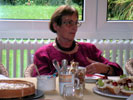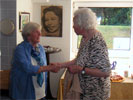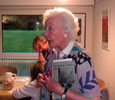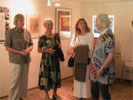|
About the Plech Labyrinth
Clicking the pictures opens a popup window with
a larger one.
To close the window use the X-button. |
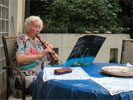 In
Nürnberg a circle of friends, involved with
the labyrinth, gathered around Anne Thurn, a now over 90 years-old
lady doctor. In
Nürnberg a circle of friends, involved with
the labyrinth, gathered around Anne Thurn, a now over 90 years-old
lady doctor.
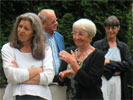 Anne Thurn, doctor and group therapist, led,
together with her late husband, Dr. Hubert Thurn (+1989), Theologist
and Psychoanalyst, a Therapy and Educational Establishment in
Plech for a number of decades, which is now managed by younger
staff.
Anne Thurn, doctor and group therapist, led,
together with her late husband, Dr. Hubert Thurn (+1989), Theologist
and Psychoanalyst, a Therapy and Educational Establishment in
Plech for a number of decades, which is now managed by younger
staff.
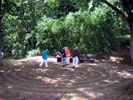 It
was her suggestion to establish a classical seven circuit
labyrinth in Plech located on a terrace of the "Gottvaterberg"
(mountain God Father). Immediately behind the church a path with
stone steps leads to the hill where the labyrinth is located below
high lime trees on a former children's playground. Planned by
the artist Martin Gebhardt, executed by the Master stone mason
Erwin Mehlinger in Dolomite stones. The official opening took
place on June 6, 1999. It
was her suggestion to establish a classical seven circuit
labyrinth in Plech located on a terrace of the "Gottvaterberg"
(mountain God Father). Immediately behind the church a path with
stone steps leads to the hill where the labyrinth is located below
high lime trees on a former children's playground. Planned by
the artist Martin Gebhardt, executed by the Master stone mason
Erwin Mehlinger in Dolomite stones. The official opening took
place on June 6, 1999.
To see more pictures from the
labyrinth go to the Photo
Gallery >
|
| 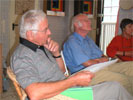 According
to Friedrich Dürr, the word "Labyrinth"
in the language of the old Cretans, could be defined as: "To
the center point those who are going astray!" To him, especially
the elements of the double helix and the cross are combined
in the (Cretan) labyrinth. The double helix symbolises the
indivisibility of death/mortality (the inward turning coil)
and life/reincarnation (the outward turning coil). The symbol
of the cross portraits man standing erect, who from his point
of view determines the location of above and below, left and
right as well as front and back. According
to Friedrich Dürr, the word "Labyrinth"
in the language of the old Cretans, could be defined as: "To
the center point those who are going astray!" To him, especially
the elements of the double helix and the cross are combined
in the (Cretan) labyrinth. The double helix symbolises the
indivisibility of death/mortality (the inward turning coil)
and life/reincarnation (the outward turning coil). The symbol
of the cross portraits man standing erect, who from his point
of view determines the location of above and below, left and
right as well as front and back.
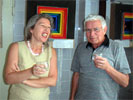 Taken
by themselves, both symbols are older than the labyrinth
itself which is older than Christianity. But seeing both
symbols ingeniously integrated into the labyrinth, its message
may well read: Mankind orients its journey through life by
permanently being conscious of its mortality -a universal
law- toward a goal, the labyrinthine middle as the turning
point from death to life. Taken
by themselves, both symbols are older than the labyrinth
itself which is older than Christianity. But seeing both
symbols ingeniously integrated into the labyrinth, its message
may well read: Mankind orients its journey through life by
permanently being conscious of its mortality -a universal
law- toward a goal, the labyrinthine middle as the turning
point from death to life.
A poem (translated):
Approximation to the Labyrinth >
|
|
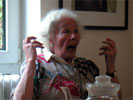 The
labyrinth in the church San Vitale in Ravenna (Italy) connects
the shell of St. James. The message is: Whoever is seeking Jesus
Christ, the center of the life, shall undertake a pilgrimage to
Santiago de Compostela. People living in the
neighbourhood of the "Gottvaterberg" along with members
of the Plech Therapy Center researched old St. James pilgrimage
paths, especially along the old way East, the
"golden street" through Prague - Königgrätz
- Glatz - Neisse - to Krakau. In the Middle Ages the pilgrimages
to Santiago de Compostela joined the different regions of Europe
amongst themselves. For the new Europe central ideas with deeper
roots than offered by technology and business are needed. The
labyrinth in the church San Vitale in Ravenna (Italy) connects
the shell of St. James. The message is: Whoever is seeking Jesus
Christ, the center of the life, shall undertake a pilgrimage to
Santiago de Compostela. People living in the
neighbourhood of the "Gottvaterberg" along with members
of the Plech Therapy Center researched old St. James pilgrimage
paths, especially along the old way East, the
"golden street" through Prague - Königgrätz
- Glatz - Neisse - to Krakau. In the Middle Ages the pilgrimages
to Santiago de Compostela joined the different regions of Europe
amongst themselves. For the new Europe central ideas with deeper
roots than offered by technology and business are needed.
The labyrinth is a cure for both man and our earth. The labyrinth
teaches slowness and is a remedy against haste and hurry of our
present time. It teaches patience, forbearance and moderation.
The labyrinth also teaches: The end is always the beginning.
Excerpt from a guide for the Plech
Labyrinth with ideas from Anne Thurn (Dr.phil. and Dr.med.).
to the top |
 In
Nürnberg a circle of friends, involved with
the labyrinth, gathered around Anne Thurn, a now over 90 years-old
lady doctor.
In
Nürnberg a circle of friends, involved with
the labyrinth, gathered around Anne Thurn, a now over 90 years-old
lady doctor. Anne Thurn, doctor and group therapist, led,
together with her late husband, Dr. Hubert Thurn (+1989), Theologist
and Psychoanalyst, a Therapy and Educational Establishment in
Plech for a number of decades, which is now managed by younger
staff.
Anne Thurn, doctor and group therapist, led,
together with her late husband, Dr. Hubert Thurn (+1989), Theologist
and Psychoanalyst, a Therapy and Educational Establishment in
Plech for a number of decades, which is now managed by younger
staff. It
was her suggestion to establish a classical seven circuit
labyrinth in Plech located on a terrace of the "Gottvaterberg"
(mountain God Father). Immediately behind the church a path with
stone steps leads to the hill where the labyrinth is located below
high lime trees on a former children's playground. Planned by
the artist Martin Gebhardt, executed by the Master stone mason
Erwin Mehlinger in Dolomite stones. The official opening took
place on June 6, 1999.
It
was her suggestion to establish a classical seven circuit
labyrinth in Plech located on a terrace of the "Gottvaterberg"
(mountain God Father). Immediately behind the church a path with
stone steps leads to the hill where the labyrinth is located below
high lime trees on a former children's playground. Planned by
the artist Martin Gebhardt, executed by the Master stone mason
Erwin Mehlinger in Dolomite stones. The official opening took
place on June 6, 1999. According
to Friedrich Dürr, the word "Labyrinth"
in the language of the old Cretans, could be defined as: "To
the center point those who are going astray!" To him, especially
the elements of the double helix and the cross are combined
in the (Cretan) labyrinth. The double helix symbolises the
indivisibility of death/mortality (the inward turning coil)
and life/reincarnation (the outward turning coil). The symbol
of the cross portraits man standing erect, who from his point
of view determines the location of above and below, left and
right as well as front and back.
According
to Friedrich Dürr, the word "Labyrinth"
in the language of the old Cretans, could be defined as: "To
the center point those who are going astray!" To him, especially
the elements of the double helix and the cross are combined
in the (Cretan) labyrinth. The double helix symbolises the
indivisibility of death/mortality (the inward turning coil)
and life/reincarnation (the outward turning coil). The symbol
of the cross portraits man standing erect, who from his point
of view determines the location of above and below, left and
right as well as front and back. Taken
by themselves, both symbols are older than the labyrinth
itself which is older than Christianity. But seeing both
symbols ingeniously integrated into the labyrinth, its message
may well read: Mankind orients its journey through life by
permanently being conscious of its mortality -a universal
law- toward a goal, the labyrinthine middle as the turning
point from death to life.
Taken
by themselves, both symbols are older than the labyrinth
itself which is older than Christianity. But seeing both
symbols ingeniously integrated into the labyrinth, its message
may well read: Mankind orients its journey through life by
permanently being conscious of its mortality -a universal
law- toward a goal, the labyrinthine middle as the turning
point from death to life. The
labyrinth in the church San Vitale in Ravenna (Italy) connects
the shell of St. James. The message is: Whoever is seeking Jesus
Christ, the center of the life, shall undertake a pilgrimage to
Santiago de Compostela. People living in the
neighbourhood of the "Gottvaterberg" along with members
of the Plech Therapy Center researched old St. James pilgrimage
paths, especially along the old way East, the
"golden street" through Prague - Königgrätz
- Glatz - Neisse - to Krakau. In the Middle Ages the pilgrimages
to Santiago de Compostela joined the different regions of Europe
amongst themselves. For the new Europe central ideas with deeper
roots than offered by technology and business are needed.
The
labyrinth in the church San Vitale in Ravenna (Italy) connects
the shell of St. James. The message is: Whoever is seeking Jesus
Christ, the center of the life, shall undertake a pilgrimage to
Santiago de Compostela. People living in the
neighbourhood of the "Gottvaterberg" along with members
of the Plech Therapy Center researched old St. James pilgrimage
paths, especially along the old way East, the
"golden street" through Prague - Königgrätz
- Glatz - Neisse - to Krakau. In the Middle Ages the pilgrimages
to Santiago de Compostela joined the different regions of Europe
amongst themselves. For the new Europe central ideas with deeper
roots than offered by technology and business are needed.